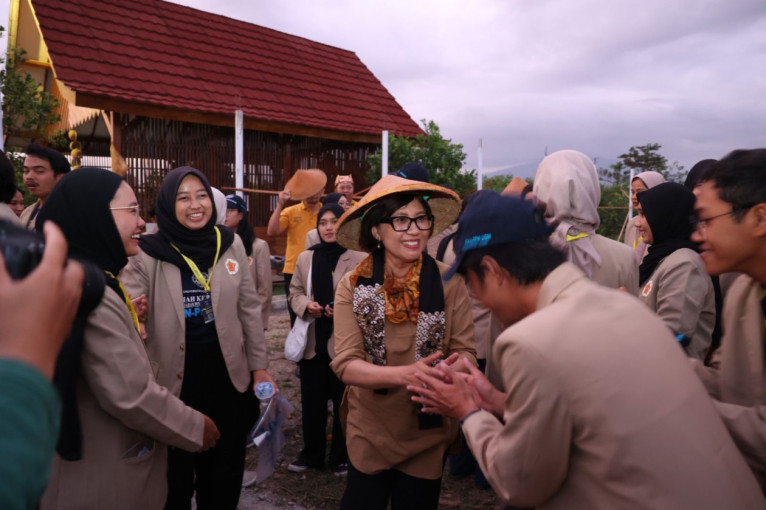
The Rector of Universitas Gadjah Mada (UGM), Professor Ova Emilia, MD, inspected the Community Service (KKN-PPM) activities in Banyuwangi Regency, East Java Province, on Friday (28/7).
The activities were located around the coastal area of Pulau Merah, precisely in Pesanggaran Village, Pesanggaran District, Banyuwangi.
During the meeting with the students at the Dragon Fruit Farm in Pesanggaran, Banyuwangi, the rector appreciated several dragon fruit processed products made by the students as part of the development of agrotourism and empowerment of Micro, Small, and Medium Enterprises practitioners.
The Student Coordinator of the Pesanggaran Unit, Dinda Lutfia Nabilla, mentioned that at least 30 students in Pesanggaran were implementing 150 work programs, and they focused on five primary programs.
Among them were four flagship programs, including agrotourism development to support nature-based tourism, SDGs-based digitalization of MSMEs, liquid organic fertilizer production, and childhood stunting eradication efforts.
“We focus on implementing agrotourism development to support nature-based tourism and SDGs-based digitalization of MSMEs,” she said.
Nabilla explained that dragon fruit products were chosen to support agrotourism based on nature.
Students worked with MSMEs practitioners and the local community to process dragon fruit into agro-industrial products such as dragon fruit bakpia, dragon fruit jam, and antioxidant-rich dragon fruit soap.
The selection of dragon fruit as an agricultural commodity was because most villagers were dragon fruit farmers.
“About 70% of our programs with the community are related to derivative products from dragon fruit,” she said.
Furthermore, the students also designed branding strategies for bakpia. These post-harvest products will be packaged and branded as souvenirs typical of Pesanggaran Village’s tourism.
“We are collaborating with MSMEs Center in Pesanggaran Village,” she said.
For the SDGs-based Digitalization of MSMEs program, the coordinator said they assisted in creating social media, provided marketing and branding education, and conducted training on copywriting and product photography for practitioners in the village.
This was related to strengthening tourism in the Pesanggaran area, focusing on Pulau Merah Beach, Pancer Beach, and Lampon Beach. In addition to assisting in creating documentary videos about the village, the students also promoted increased use of social media for tourism promotion and MSMEs products.
As for the childhood stunting eradication program, the students collaborated with the local community health center through several social activities, which were also used to explain anti-childhood stunting actions for pregnant women and promote dental and oral health.
The Student Coordinator of the Siliragung Unit, Andini Lestari, stated that they developed a training program to make liquid organic fertilizer by utilizing organic waste from fruit leftovers to reduce the use of chemicals in agricultural land.
The team also trained on making Urea Molasses Mineral Blocks (UMMB), a mineral-rich solid supplement for ruminants.
“In this program, the students educate the community about the benefits of UMMB and provide training on how to make UMMB for farmers through videos that will be shared with the community as a reference,” she explained.
Zaenab Albiya (45), a resident of Pesanggaran and the head of the MSMEs Center in the village, said that the work programs by students had helped market dragon fruit products and trained homemakers in making food from dragon fruit.
“Innovations like this are perfect. Not only were we trained on how to market on social media, but also the trained residents can hopefully pass on their knowledge,” she said.
Albiya hoped that the MSMEs in Pesanggaran could continue the dragon fruit product innovations created by the students.
She mentioned that over half of the residents of Pesanggaran are dragon fruit and orange farmers. Although the fruits are exported, dragon fruit prices sometimes become cheap during harvest seasons.
“When they are abundant, they are often discarded, so we make various processed products to increase the value, produce them, and make it more practical to carry,” she said.
Rector Ova Emilia appreciated the products created by students to increase economic opportunities for residents, who are mostly dragon fruit farmers.
“Hopefully, the ideas and creations that have been presented can be followed up,” said the rector.
Professor Emilia mentioned that she had tasted several processed products made by the students, such as dragon fruit juice, dragon fruit bakpia, and pudding, which she found delicious.
“I have tried the bakpia, and it was delicious. I think this can add value for the local community,” the rector said.
On this occasion, the rector stated that student community service is one of the flagship programs of Universitas Gadjah Mada to contribute to developing various regions across Indonesia.
“Not all universities have field activities like this. Student participation in community service can provide extraordinary learning experiences, more than what they can get from the on-campus learning,” she explained.
In Banyuwangi Regency, UGM sent four teams across four districts: Pesanggaran, Siliragung, Wongsorejo, and Kalibaru.
These activities are part of the participation of 7,079 UGM students sent to serve in 31 provinces, 97 regencies, 204 districts, and over 400 villages across Indonesia.
Author: Gusti Grehenson
Photographer: Firsto

